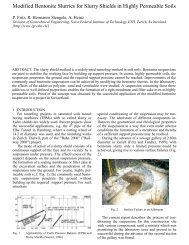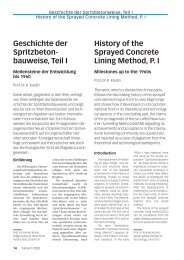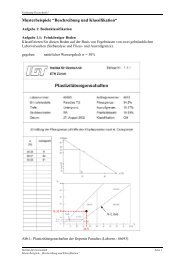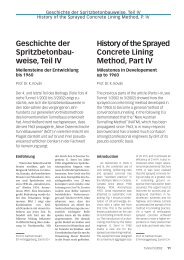Erroneous Concepts behind NATM
Erroneous Concepts behind NATM
Erroneous Concepts behind NATM
Create successful ePaper yourself
Turn your PDF publications into a flip-book with our unique Google optimized e-Paper software.
PROTECTIVE RING (GROUND RING)<br />
TODAY EARLIER<br />
GROUND RING<br />
Fig. 5 Protective rings (ground rings) according to Müller Fig. 6 Ground ring according to<br />
and Fecker [10] Rabcewicz (1944, [11])<br />
- according to Rabcewicz [11] such rings are in contact to the openings, whereas for<br />
Müller and Fecker [10] they are not (Fig. 5 and 6).<br />
- the ground rings allegedly have to be mobilized by means of admissible rock<br />
deformations, otherwise they do not develop. If the rock deformation is insufficient,<br />
these ground zones do not close to a ring [1].<br />
- from the point of view of tunnel statics only the lining [1] and the ground ring (Fig. 7)<br />
should count. The latter seems to be loaded one way or another. Prior to the <strong>NATM</strong><br />
concept, the ground ring apparently did not play a part.<br />
- in the case of multiple adit excavation method (Fig. 8) a series of ground rings is<br />
supposedly formed [12], which according to the understanding of the <strong>NATM</strong>, is detrimental<br />
to the rock mass. Thus the <strong>NATM</strong> propagates full face excavation as one of its<br />
main principles. Plastic zones interrupt the ground rings [13].<br />
P<br />
h<br />
TODAY EARLIER<br />
P i<br />
LINING<br />
P<br />
v<br />
GROUND RING<br />
P<br />
v<br />
P h<br />
CULVERT<br />
Fig. 7 Ground ring according to Müller and Fecker [10] Fig. 8 Ground rings around multiple adits<br />
according to Müller [12]<br />
6






